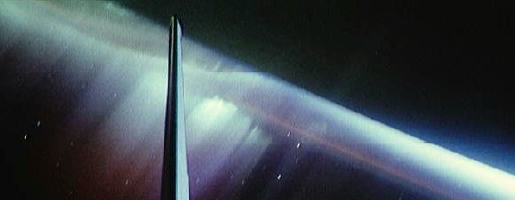 |
|||
|
The
Aurora Borealis (and Space Shuttle tail).
|
|||
| EARTH'S MAGNETIC FIELD | |||
| The Earth has the strongest magnetic field of the inner planets, protecting it from the mixture of charged particles in the solar wind. The magnetosphere is the region around a planet where the planet's magnetic field is dominant, rather than the Sun's. Most particles are deflected around the Earth, but some become trapped in the magnetosphere, producing belts of ionised particles and brilliant auroral displays if the particles reach the atmosphere. | |||
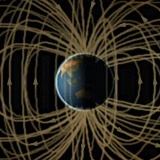 Form and main features of the Earth's magnetosphere. |
|||
| A self-exciting dynamo | |||
| A planetary magnetic field requires a moving electrical conductor and it seems that the Earth's liquid iron outer core acts like a huge electromagnet. Assuming a small, stray magnetic field to begin with, the planet's rotation and convection in the hot, electrically-conducting fluid outer core would induce electrical currents. The electrical currents in turn induce a stronger magnetic field, which reinforces the electrical currents. The result is a self-sustaining magnetic field, aligned approximately along the axis of the Earth's rotation. The electrical current required to sustain the Earth's field is about a thousand million amperes - almost as much as that generated by all the power plants on the Earth's surface - and the driving force is the convection-inducing internal heat of the Earth's core. | |||
 Electrical currents in the Earth's outer core give rise to a magnetic field. |
|||
| The Magnetic Field | |||
| In fact, the electrical north and south poles wander by up to a degree over several years and the centre of the magnetic field seems to be about 400 kilometres away from the geometrical centre of the Earth. In addition to the wandering of the magnetic field, the rock record indicates that the polarity of the field reverses from time to time. This mechanism is poorly-understood, but a detailed history of reversals has been established for the last 7 million years, with major reversals occurring approximately every half-million years. | |||
| The Earth's magnetosphere is distorted by the magnetised and electrically-conducting plasma (ionised gas) of the solar wind. It is compressed to about 64,000 kilometres (10 Earth radii) towards the Sun and stretched out several million kilometres into a magnetotail away from the Sun. Interactions between the solar wind and the magnetosphere inject a small fraction of the solar wind particles into the magnetosphere. | |||
| Radiation Belts and Aurorae | |||
| Moving charged particles from the solar wind (positive ions and negative electrons) can become trapped within the magnetosphere and space probes have detected two distinct concentrations of charged particles around the earth. Termed "radiation belts" due to the dangerous nature of ionised particles, these doughnut-shaped regions lie about 2,000 kilometres and 10,000 kilometres above the Earth's surface. They are named the Van Allen Belts after their discoverer. | |||
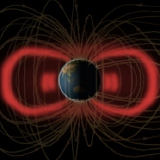 The Van Allen Belts. |
|||
| Particles can be trapped in the Van Allen Belts for decades, oscillating from north to south along the lines of the magnetic field. Some particles can make it through to the lower reaches of the magnetosphere where they can interact with the atmosphere. Here, the highly energetic particles cause transitions in the energy levels of atoms in the atmosphere, producing spectacular light shows in the process. These aurora are visible in the polar regions, above about 65 degrees latitude, where the magnetic field concentrates incoming particles like a funnel. | |||
| Auroral activity displays a variety of colours, predominantly green and red due to the excitation of atomic oxygen in the upper atmosphere. Extending up to 200 kilometres above the surface, the red colour occurs where the air is least dense, with the green lower down where the air is more dense. Sometimes a pink fringe is visible at the bottom, due to the excitation of nitrogen. The intensity varies with the particle flow to the magnetosphere from the solar wind. Aurora around the north pole are termed the Northern Lights or Aurora Borealis, and around the south pole, the Southern Lights or Aurora Australis. | |||
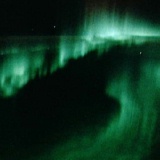 A green-phase Aurora Australis viewed from the space shuttle. |
 A green- and red-phase Aurora Australis with charged plasma. |
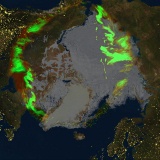 A composite image illustrates an auroral oval, centred over the magnetic north pole. |
|
|
|
|||